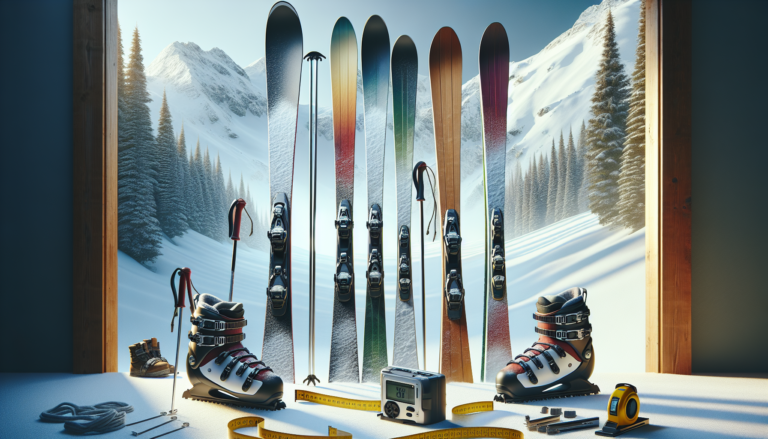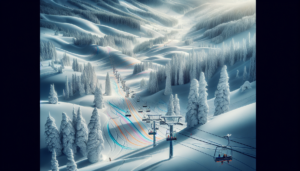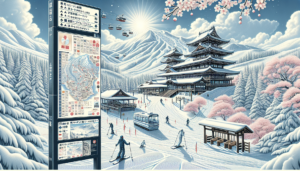Introduction to Choosing Ski Length
Selecting the right ski length is a crucial factor in ensuring a safe and enjoyable skiing experience. The ideal ski length depends on various factors, including the skier’s height, weight, skill level, and preferred terrain. Choosing the appropriate ski length can significantly impact a skier’s performance and overall satisfaction on the slopes.
In this comprehensive guide, we will explore the key considerations when determining the perfect ski length for you. From understanding why ski length matters to examining the factors that influence length selection, we will provide you with the knowledge and tools necessary to make an informed decision.
Why Ski Length Matters
Ski length plays a vital role in a skier’s ability to control and maneuver their skis effectively. Skis that are too short may hinder stability and performance, while skis that are too long can be challenging to control, especially for beginners. The right ski length strikes a balance between maneuverability and stability, allowing skiers to confidently navigate various terrains and snow conditions.
Shorter skis are generally easier to turn and control, making them suitable for beginners and those who prefer quick, agile movements. Longer skis, on the other hand, provide greater stability at higher speeds and are often preferred by advanced skiers who enjoy tackling steeper slopes and more challenging terrain.
Factors Influencing Ski Length
Several factors come into play when determining the ideal ski length for an individual skier. These include:
- Height and weight: A skier’s height and weight serve as a starting point for determining ski length. Taller and heavier skiers generally require longer skis for better stability and float in deep snow.
- Skill level: Beginner skiers often benefit from shorter skis, which are easier to control and maneuver. As skiers progress in skill, they may opt for longer skis that offer improved stability and performance.
- Skiing style and terrain preference: The type of skiing a person enjoys, such as groomed runs, powder, or park skiing, can influence ski length selection. Different ski categories, such as all-mountain, freestyle, or powder skis, have specific length recommendations based on their intended use.
By taking these factors into account, skiers can narrow down their ski length options and find the size that best suits their individual needs and preferences.
Ski Length Based on Skill Level
A skier’s skill level is one of the primary considerations when selecting ski length. Beginners, intermediate, and advanced skiers have different requirements and preferences when it comes to ski size. Understanding how skill level impacts ski length can help skiers make an informed decision and progress in their skiing abilities.
Beginner Ski Length Recommendations
For those new to skiing, shorter skis are generally recommended. Skis that fall between the chin and nose in length are ideal for beginners, as they offer better control and maneuverability. Shorter skis are easier to turn and require less effort to initiate and complete turns, making the learning process more manageable and enjoyable.
Beginners should focus on developing proper technique and building confidence on the slopes. Shorter skis allow for quicker, more responsive movements, enabling beginners to master the fundamentals of skiing before progressing to longer skis.
Intermediate Ski Length Recommendations
As skiers advance in skill and techniques, they may consider moving up to a slightly longer ski length. Intermediate skiers should look for skis that fall between the nose and forehead in length. These longer skis provide increased stability and performance, allowing intermediate skiers to tackle more challenging terrain and snow conditions.
Intermediate skiers can benefit from the added stability of longer skis when skiing at higher speeds or navigating steeper slopes. However, it’s essential to find a balance between stability and maneuverability to ensure a comfortable and enjoyable skiing experience.
Advanced Ski Length Recommendations
Advanced and expert skiers often prefer longer skis that offer maximum stability and performance. Skis that reach the forehead or even slightly above are suitable for advanced skiers who have mastered the techniques and are confident in their abilities.
Longer skis provide advanced skiers with the stability needed to handle high speeds, steep terrain, and variable snow conditions. They also offer better float in deep powder, making them ideal for off-piste skiing and exploring backcountry terrain.
However, advanced skiers should also consider their personal preferences and skiing style when selecting ski length. Some advanced skiers may prefer slightly shorter skis for increased maneuverability in tight spaces or for performing tricks in the park.
Ski Length Based on Physical Attributes
In addition to skill level, a skier’s physical attributes, such as height and weight, play a significant role in determining the appropriate ski length. Manufacturers often provide size charts that recommend ski lengths based on these factors, serving as a helpful starting point for skiers.
Using Height to Determine Ski Length
Height is a primary factor in selecting ski length, as it directly influences a skier’s center of gravity and balance on the skis. A general rule of thumb is to choose skis that fall between the chin and the top of the head when standing upright.
| Height (cm) | Recommended Ski Length (cm) |
|---|---|
| 150-160 | 145-160 |
| 160-170 | 155-170 |
| 170-180 | 165-180 |
| 180-190 | 175-190 |
| 190+ | 185+ |
Skiers can use their height as a starting point and then make adjustments based on their skill level and personal preferences. Beginners may opt for skis on the shorter end of the range, while advanced skiers may choose skis on the longer end for increased stability.
Using Weight to Determine Ski Length
Weight is another important factor to consider when selecting ski length. Heavier skiers generally require longer skis to provide adequate support and stability, especially in deeper snow conditions. Lighter skiers, on the other hand, may find shorter skis more manageable and easier to control.
Ski manufacturers often provide weight ranges along with their ski length recommendations to help skiers find the right fit. It’s essential to consider both height and weight when making a decision, as a skier’s proportions can impact their skiing performance and comfort.
Ski Length for Children
Choosing the right ski length for children is crucial for their safety, comfort, and enjoyment on the slopes. Children’s ski lengths differ from adult recommendations, as their smaller stature and developing skills require specific considerations.
General Guidelines for Kids’ Ski Length
When selecting skis for children, a good rule of thumb is to choose skis that fall between their chest and nose in length. This range allows for better control and maneuverability, making it easier for kids to learn and progress in their skiing abilities.
Here are some general guidelines for children’s ski lengths based on their height:
| Child’s Height (cm) | Recommended Ski Length (cm) |
|---|---|
| 70-100 | 70-90 |
| 100-125 | 90-110 |
| 125-150 | 110-130 |
| 150-165 | 130-150 |
It’s important to keep in mind that these are general recommendations, and parents should also consider their child’s skill level and weight when making a final decision.
Adjusting Ski Length for Child’s Skill Level
Just like adult skiers, children’s ski lengths can be adjusted based on their skill level. Beginners may benefit from shorter skis, which are easier to control and turn, while more advanced young skiers can handle slightly longer skis for improved stability and performance.
When in doubt, it’s always better to err on the side of shorter skis for children. Shorter skis are more forgiving and can help build confidence, while skis that are too long can be overwhelming and hinder progress. As children grow and develop their skills, they can gradually move up to longer ski lengths.
Ski Length for Different Terrains and Conditions
The type of terrain and snow conditions a skier encounters can also influence the choice of ski length. Different ski categories, such as all-mountain, freestyle, and powder skis, have specific length recommendations based on their intended use and the skier’s preferences.
Choosing Ski Length for Various Terrains
All-mountain skis, designed for versatility across different terrains, typically have a mid-range length that balances maneuverability and stability. Skiers who enjoy a mix of groomed runs, moguls, and occasional off-piste skiing can benefit from all-mountain skis in their recommended size range.
Freestyle skis, used for park and pipe skiing, are often shorter in length to allow for easier maneuverability and trick execution. Skiers who primarily focus on freestyle skiing may prefer skis that fall on the shorter end of their recommended size range for increased agility.
Powder skis, designed for deep snow conditions, are generally longer and wider than other ski categories. The added length and width provide better float and stability in soft snow. Skiers who frequently encounter powder conditions may opt for longer skis to enhance their performance and enjoyment in deep snow.
Choosing Ski Length for Different Snow Conditions
Snow conditions can vary greatly, from hard-packed groomers to soft powder, and ski length can be adjusted accordingly. In general, longer skis perform better in deeper snow, providing more float and stability. Shorter skis, on the other hand, are more maneuverable in firmer snow conditions and are easier to control on icy or hard-packed surfaces.
Skiers who frequently encounter a variety of snow conditions may benefit from choosing a ski length that falls in the middle of their recommended range. This provides a balance of stability and maneuverability, allowing them to adapt to changing snow conditions throughout the season.
Additional Tips for Choosing the Right Ski Length
While ski length charts and recommendations based on height, weight, and skill level serve as valuable starting points, there are additional factors to consider when making a final decision. Here are some tips to help you fine-tune your ski length selection:
Consulting Ski Length Charts
Ski length charts provided by manufacturers offer a general guideline for selecting the appropriate ski size. These charts typically take into account the skier’s height and sometimes weight, providing a range of recommended ski lengths.
When consulting a ski length chart, it’s essential to consider your skill level and personal preferences. If you’re unsure, it’s generally better to choose a ski length that falls in the middle of the recommended range, as this offers a balance of stability and maneuverability.
Considering Ski Design and Profile
The design and profile of a ski can impact how its length feels and performs on the snow. Skis with a rockered profile, where the tips and tails are raised off the snow, can feel shorter than their actual length. In this case, skiers may opt for a slightly longer ski to compensate for the reduced effective edge.
Similarly, skis with a wider waist width may require a shorter length compared to narrower skis. The increased surface area of wider skis provides more float and stability, allowing skiers to downsize without compromising performance.
Seeking Expert Advice
When in doubt, seeking advice from experienced skiers or professional ski shop staff can be invaluable. These experts can assess your individual needs, take into account your skill level and skiing preferences, and provide personalized recommendations for ski length.
If possible, demo different ski lengths and models before making a purchase. Many ski resorts and shops offer demo programs that allow skiers to try out various skis on the slopes. This hands-on experience can help you determine which ski length feels most comfortable and suits your skiing style.
Conclusion
Choosing the right ski length is a critical aspect of ensuring a safe, comfortable, and enjoyable skiing experience. By considering factors such as skill level, height, weight, terrain preference, and snow conditions, skiers can narrow down their options and select a ski length that optimizes their performance on the slopes.
Remember, ski length recommendations serve as a starting point, and personal preferences and individual needs may vary. Don’t hesitate to seek advice from experienced skiers or professionals, and take advantage of demo opportunities to find the perfect ski length for you.
With the right ski length, you’ll be well-equipped to tackle the slopes with confidence and progress in your skiing abilities. Embrace the learning process, have fun, and enjoy the thrill of gliding down the mountain on a pair of skis that feel just right for you.






